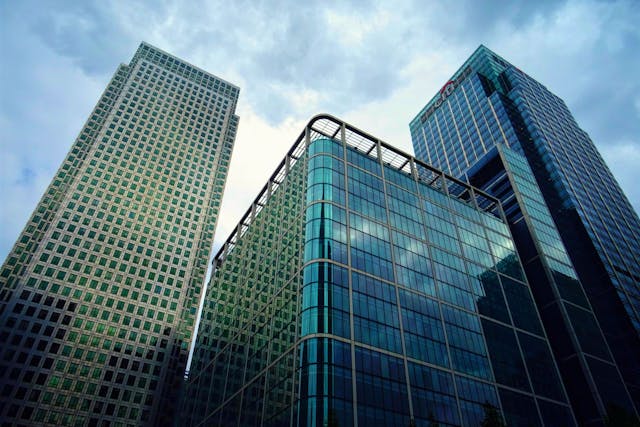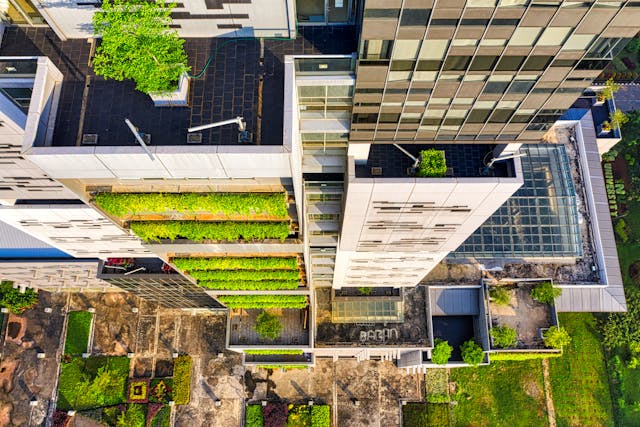
In the London commercial real estate market, sustainable office design is no longer a trend, but a defining factor. With growing pressure from regulatory requirements, corporate ESG commitments, and changing tenant expectations, demand for green office spaces has never been higher. As a result, businesses and landlords are rethinking their approach to office space.
One of the key ways they’re doing this is through BREEAM certification, which stands for Building Research Establishment Environmental Assessment Method. Originating in the UK, BREEAM is a guideline for sustainable building design that is now accepted as a gold standard the world over. But what exactly does BREEAM involve, and why does it matter for landlords and occupiers in the London office market? Let’s take a look at how London offices are going green through this accredited standard.
The Green Shift in London’s Office Market
The demand for sustainable office spaces in London has surged in recent years, driven by stronger enforcement of corporate responsibility schemes and stricter government regulations, such as Net Zero Commitments, ESG (Environmental, Social, and Governance) Requirements, and Minimum Energy Efficiency Standards (MEES).
This has caused a shift in how commercial real estate is valued. For example, Grade A offices are now exclusively comprised of those that meet green criteria. As a result, landlords are prioritising green features that improve energy efficiency, reduce waste, and create healthier working environments.
Green leases, a joint effort between landlords and occupiers to use and manage offices with a focus on sustainability and well-being, are also on the rise.
Lastly, a growing number of office landlords are considering retrofitting as a viable option, in order to target a better BREEAM rating.

What Is BREEAM?
BREEAM (Building Research Establishment Environmental Assessment Method) is one of the most widely recognised sustainability certification schemes for buildings at global level. Developed in the UK in 1990 by the Building Research Establishment (BRE), it sets the benchmarks needed to assess a building’s environmental performance.
10 Key BREEAM Criteria
To become BREEAM-certified and join the global BREEAM communities of buildings that have been guided by thoughtful energy and environmental design principles, a structure is assessed across 10 key categories, each contributing to its overall sustainability rating. Here’s what these criteria cover and how buildings can improve their scores:
- Energy – Measures how efficiently a building uses energy.
- Installing energy-efficient lighting like LED, motion sensors, and eco-friendly HVAC systems.
- Integrating renewable energy sources on-site to reduce energy consumption from the grid, like solar panels or ground-source heat pumps.
- Health & Wellbeing – Focuses on comfort, for instance by targeting air quality and lighting.
- Using low-VOC (volatile organic compound) and sustainable materials to improve indoor air quality.
- Maximising natural light, adding skylights, or smart lighting controls.
- Incorporating biophilic design elements, such as indoor plants and green walls.
- Innovation – Rewards forward-thinking sustainability initiatives.
- Using AI-driven systems to optimise heating, cooling, and lighting based on occupancy.
- During construction, using innovative, eco-friendly materials with a lower environmental impact, like zero-carbon concrete or pollution-absorbing bricks.
- Land Use & Ecology – Evaluates the building’s impact on biodiversity.
- Creating green roofs or landscaping wetlands to support urban wildlife.
- Implementing biodiversity action plans, such as installing bee hotels or bird nesting boxes.
- Materials – Assesses the sustainability and lifecycle impact of construction materials.
- Sourcing materials with environmental certifications, such as FSC-certified wood or A+ insulation.
- Choosing office furniture with EPD (Environmental Product Declaration).
- Management – Looks at how sustainability measures are planned and handled.
- Conducting sustainability training for building management teams and tenants.
- Implementing clear policies, like waste reduction or green procurement strategies.
- Pollution – Addresses emissions, noise, and pollution control.
- Installing electric vehicle (EV) charging stations to promote low-emission transport.
- Implementing sustainable drainage systems to prevent water pollution.
- Reduction of noise pollution.
- Transport – Rates accessibility and sustainable travel options.
- Providing cycle storage, showers, and changing facilities to encourage cycling to work.
- Introducing car-sharing schemes or shuttle services for employees.
- Waste – Focuses on reducing, reusing, and responsibly disposing of materials.
- Setting up comprehensive waste reduction programs, recycling, and composting facilities within the building.
- Implementing a circular economy approach by repurposing materials during building construction or refurbishments.
- Water – Measures efficiency in water use and conservation.
- Installing water-efficient fixtures, such as low-flow taps and dual-flush toilets.
- Using rainwater harvesting systems for irrigation and toilet flushing.
- Greywater recycling to reduce freshwater consumption.
Each of these 10 categories is scored and then buildings are given a BREEAM rating ranging from Pass, Good, Very Good, Excellent, to Outstanding, given as a percentage score.

Why BREEAM Certification Matters
For landlords, achieving a high BREEAM rating makes their property more attractive to corporate tenants prioritising sustainability. For example, certified buildings achieve higher rental and resale value. Green buildings will also often command premium rates in the market, estimated at more than 25% of the average rate for a given area.
These buildings also have a better standing in terms of regulatory compliance, as the improvements needed to get certified help future-proof real estate against stricter environmental regulations.
For businesses, operating in a certified building helps them meet their own environmental goals and improve employee well-being. Not only that, tenants may also enjoy lower operating costs, as energy-efficient buildings reduce utility bills and maintenance costs.
Additional benefits include intangibles like enhanced comfort (potentially leading to better productivity and staff retention) and an enhanced corporate image or social value, since the certification shows commitment to sustainability, which appeals to investors, clients, and employees.
Notable BREEAM-Certified Office Buildings in London
The UK is a global leader in number of certifications, many of which are in London, especially in major office hubs in Canary Wharf and King’s Cross.
- The Scalpel (City of London) – Achieved BREEAM Excellent thanks to the use of energy-efficient systems and sustainable construction materials.
- 22 Bishopsgate – The city’s first vertical office village is one of the most sustainable skyscrapers in London.
- Google’s Kings Cross HQ (“The Landscraper”) – Built with sustainability at its core, this building achieved an Outstanding rating and meets other sustainability frameworks.
- Bloom Clerkenwell – A BREEAM Outstanding office building, which also has excellent ratings in other green schemes.
- JJ Mack building in Farringdon, the most sustainable office building in the country.
Conclusion
As sustainability becomes a core requirement in transactions involving commercial buildings, the London office market is adapting to meet the new standards. BREEAM certification plays a crucial role in shaping greener workspaces and contributes to creating healthier work environments and high-performing office buildings. With green buildings commanding premium rents and attracting top-level tenants, the future of the London office market is undeniably green.
Interested in Energy Efficient and Sustainable Office Space Options in London?
If the above has got you inspired to set up your new venture in a space where sustainable building practices have been at the forefront, or you’re now wanting to move your operations to an officially BREEAM-certified building, we have a wide range of sustainable office space options to fit any business or nonprofit, whatever your growth stage.
Feel free to call us on 020 3965 9617 to speak with one of our friendly and knowledgeable office space consultants. Whether your priorities are lowering your operating energy costs, reducing carbon emissions, or improving the air quality of your new business HQ, our workspace professionals can help you and your company find the perfect office space in Central or Outer London to meet your specific eco-friendly office requirements.
For further reading, click below for some of our other recent articles on the topics of commercial property, business, and the workplace:
London Commercial Space Trends
Return to Office: UK Workers Surveyed About RTO Mandates
Office Christmas Party Ideas: Not the Traditional, Boozy ‘Do
The Most Haunted Places in London, England: Office Buildings Edition
Gen Z in the Workplace: A Comprehensive Guide
The Benefits of Having Plants in the Office
Cycling to Work in London: Bike-Friendly Office Locations
London Office Market Report 2024
